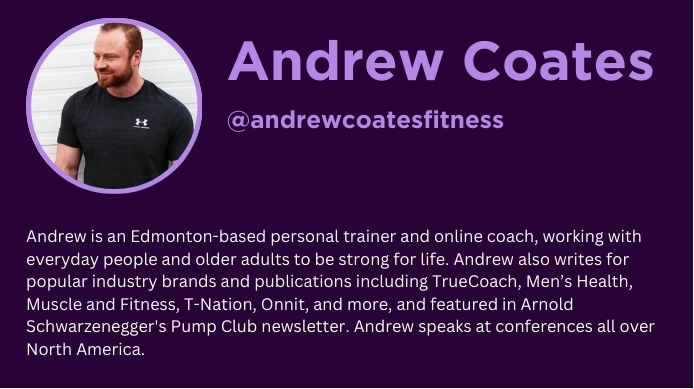Experienced in-person coaches are often victims of our own success. Entrenched thinking and behavior which served our success in-person, leaves us struggling to adapt to technology driven changes and opportunities to our industry. We’re often slow or unable to move at all into online coaching. We believe we can’t replicate the in-person experience and aren’t willing to compromise on our process. We’ve worked this way for so long, it feels difficult to unlearn old skills and biases and embrace a new approach. We’ve been told to double down on our strengths and find our niche. Online training couldn’t possibly offer the same quality experience and its for a new generation of young trainers not me, right? Don’t be so sure.

Experienced coaches have mastered the science and the art of coaching the client in real time right in front of us. We’ve built relationships, some spanning decades, and greet new referrals by handshake and a gym tour. We schedule 2-3 regular weekly meetings to build client strength and hold them accountable. But this isn’t the reason for career longevity. The underlying care, relationship, and ability to adjust to the client’s needs are the true drivers of success. We now know we can do all of this online. We just need to embrace and develop a new set of structures, a few skills, and an open mind.
The new model of personal training has newer trainers learning online coaching almost concurrently with the in-person craft. The prevalence of social media and a giant kick in the teeth by a global pandemic means our industry is forever changed. Hybrid in-person and online coaching is the future. The old guard are missing an opportunity to take their skill and experience and dominate in a growing consumer market. For years, most clients and fitness consumers didn’t view online coaching a viable option. It was for bodybuilders, not accountants, college students, and working moms. The growth of online coaching has normalized having an online coach while exploding the pool of potential clients. Online clients aren’t just the same pool of in-person clients who’ve adapted, nor is the in-person dying off. The growth is a blue ocean of new consumers who’s lives never accommodated a fixed trainer schedule or needed or valued the “hand holding” or interpersonal interaction of a trainer. These are people who instead see the value in a structured program and the support an online coach provides. Online coaching is growing an entirely new base of potential clients as it becomes a mainstream and reputable option.
Even before the pandemic forced many hands, trainers have been exploring online businesses with great success. Coaches sought more income, flexibility, or just wanted a change from the gym floor and time for money trade. Jamie Postill, an Edmonton based trainer, switched to online when she found coaching in-person emotionally draining after years in the business. It later proved sustainable through and after her pregnancy.
Steven Hicks shattered his tibia in 2019 forcing him from the gym. He had recently moved from Seattle to Spokane and the combination of move and injury pushed all his chips into online training, where he’s enjoyed success. Louie Guarino went exclusively online in 2015, and his subsequent move from New York City to Toronto caused no disruption in his business. If your business is entirely in-person, needing to move cities means completely starting over. Trainers often uproot to follow the career opportunity of a significant other. This means a challenging rebuild of your in-person clientele in a new city where you don’t have an established reputation or referral network.
Jordan Syatt’s online business and mentorship work travelled with him to spend time with his family in the Boston area as he took a break from pandemic shaken New York City. His online business also allowed him to accommodate travelling with famed client Gary Vaynerchuk for 3 years to train him in-person, flying weekly between New York and Los Angeles with occasional visits to London(England not Ontario). Jordan tirelessly creates online content across his podcasts, Instagram, YouTube, and now TikTok as an early adopter. While many fitness professionals make fun of and dismiss TikTok as song and dance for teenagers, Jordan is growing a following with fitness content in a space unsaturated with fitness professionals. He uses all his platforms to direct people back to his email list and online businesses.
The recent pandemic forced many to adapt or fold, as in-person training was shuttered. None of us knew how long gyms would be closed, and some states continue to bar gyms from re-opening. Carl-Erik Søbstad found his clients still wanting to workout so he created a video library, rebuilt his website, and developed systems which retrained 100% of his clients, all after avoiding online for fear his clients wouldn’t be interested. We would be unwise to dismiss this as a once in a lifetime event. The future is filled with unknown natural and man made disasters which could impact your ability to work. Having an online contingency will be the norm going forward.
Before online training became mainstream, many industry stalwarts built successful online compliments to their core business. Dean Somerset and Joe Dowdell set the standard for quality work while adding a revenue stream. With broad followings they learned they could offer their services to devoted followers who wanted to work with them but lived in other cities and countries. Others, like Bryan Krahn and Kelly Coffey, uprooted years of gym floor success and went almost exclusively online, to enjoy the schedule freedom to run their businesses completely on their terms. Bryan and Kelly dominate their respective niches, where before they were limited to locals, they’re now able to access anyone in the world who fits their speciality and preferred demographic. This freed more time to write, travel and speak at conferences, and build courses and programs which allow for scalable income and the ability to reach and help more people than training one person at a time ever could.
Start by choosing or developing an online coaching platform and your systems. Some coaches use spreadsheets and google docs to build their systems. I struggled with spreadsheets and found it held me back from wanting to expand more time into online training. A friend pointed me to try TrueCoach. I love the platform’s ease of use, for me and my clients, overcoming my default tech aversion. Create your forms, waivers, and sort out a payment system like PayPal, and get the word out among your following and former clients who’ve moved away. Apply the patience combined with relationships and marketing skills that served your in-person success and get to work building. Set appropriate boundaries on how and when clients interact with you to preserve your downtime.
Sometimes you know you want to work online but struggle to know where to start. Zach Pello wanted to have more schedule freedom and to be able to pickup his kid from school. After a phase of procrastination by getting lost in the weeds of researching and picking systems, he embraced online and built a hybrid of in-person and online. Zach sees this new model as the key to long term sustainability and avoiding burnout. Often trying to prepare and perfect everything in advance will be so daunting you never get started. Take the first step, build systems as their need arises, find out what clients need, and adapt and grow.
Here’s how 3 legendary trainers succeeded online after resisting the call for years. Perhaps not coincidentally, all 3 are former winners of The NSCA’s Personal Trainer of the Year award. As gym owners, they’re all proven coaches, educators, and business people, yet each hadn’t taken the online plunge until recently. Hopefully their stories inspires you and provide a road map how you can follow their lead if you’ve been reluctant to try coaching online after years of in-person experience. It’s never too late to add a new skill set or adapt to a shifting industry landscape.
Melody Schoenfeld, Flawless Fitness, a small private studio in Pasadena where she does one-on-one and small group training. Melody is a strength athlete, presenter, author, metal singer, and bender of metal objects. 2019 NSCA Personal Trainer of the Year.
Why had you resisted venturing into online training?
I hadn’t resisted it per se. I just wasn’t very proactive about getting started. I’m not a marketing person. I did a ton of research on marketing, read books by experienced online trainers, talked to friends who had been successful at marketing. I even hired someone who had helped a colleague form a successful marketing campaign to revamp my website. But even after all that, I just had a hell of a time embracing it. I love helping people. Marketing is just not my thing. That is to my detriment.
I did get a few online clients on my own; a few people saw it was something I was offering so they messaged me and asked about it. But it wasn’t anything I aggressively pursued. I was also approached by the folks at Macros, Inc to coach with them a while back, so I’ve been doing some online nutrition and fitness coaching with them for a few months on top of what I already do.
Any reasons you previously thought you couldn’t or shouldn’t?
I’m not an “influencer.” Not a lot of people know who I am. I don’t have millions of social media followers, and I’ve never aimed to do that. I figured I needed a much bigger audience if people were going to be interested in training with me online.
Why did you decide to embrace online? Give a brief description of how you went about it and why did it become successful?
When COVID hit and I had to shut down my studio, I didn’t have much of a choice. I’ve always been someone who is able to think and adjust quickly when needed, so I immediately realized I needed to move my training online, at least temporarily. I offered it the same day I had to close. About 65% of my clients decided to roll with streaming training. A few others asked for written programs (I already had a pretty extensive video library of instructional videos set up, so that was easy to do), and the rest wanted to wait until my studio was open. Now that my studio is open again, a lot of my clients are continuing with streaming live training until they feel safe to come back to the gym, and a few have said that they actually prefer the streaming training and want to continue that ongoing. A lot of them love the fact that they don’t have to commute or wake up earlier to go to the gym. One of my clients is the most consistent she’s ever been with her workouts now that she streams her sessions. And I have a few people from out of the area, and even out of the country, who have requested online training from me lately. I’m not sure I’ll ever get that whole marketing thing down, but online training has proven to be a useful addition and alternative for me and my clients, and I’m happy to keep it going as long as people find it helpful.
Robert Linkul MS CSCS*D NSCA-CPT*D FNSCA, owner of Be STRONGER Fitness, a personal training studio for older adults in Sacramento California and Owner of trainingtheolderadult.com, an online continued education program teaching coaches how to properly train older adults. 2012 NSCA Personal Trainer of the Year.
Why had you resisted venturing into online training?
I’m old-school and enjoy the face-to-face interaction and energy of working with people in-person. Coaching, queuing, correcting and verbally setting the tempos, expectations and mindsets of my clients is some thing that I could not see myself doing through a camera.
Were there any “lies you told yourself” about why you hadn’t tried online?
Yes, I simply didn’t think that online training could be done well and it wasn’t until I was forced to move online that I learned that it can and has been done well for a while now. Seeking inspiration from some of my colleagues I was able to design a way to implement my personal training values and business standards via a different delivery system. After two weeks of troubleshooting I feel like we figured out a very effective way to deliver our standard of service online and continue to do so today.
Any reasons you previously thought you couldn’t or shouldn’t?
Mostly based on time, I didn’t have the time to learn, develop and design a completely new business while still running our studio and my online education company. Once we were shut down however I had a lot of free time and the pressure of being forced to close definitely pushed my hand to do it quickly efficiently and professionally.
Why did you decide to embrace online?
First it was our only way to continue to grow as a business and earn an income. As the months went on and we got better at delivering an online service we opened it to new customers outside our current clientele. We’ve continued to grow and have found great value and offering this as a service permanently to our current clients on the days that they don’t come in studio and to our new clients all around the country and the world. (We have clients in the US, Canada, Ireland, Australia and Iceland).
Give a brief description of how you went about it and why did it become successful?
The key to our service is properly placing our clients in the right program design. This is done by a video movement observation session in which we observe our clients perform five basic movements, those movements are scored, interpreted and based on that information placed into one of our four program designs. We offer live streaming workouts were were able to troubleshoot and personalize exercises for our clients while they work out with us or we have to tutorial videos teaching and demonstrating each exercise and it’s make up inside the work out for them to perform on their own. We do offer one on one online training as well for clients who need it.
Chad Landers, owner of PUSH Private Fitness in Los Angeles for over 17 years. Personal Trainer for over 27 years. 2018 NSCA Personal Trainer of the Year. PUSH is a private one-on-one personal training studio. No memberships, no classes, no semi-privates or small groups…old school.
Why had you resisted venturing into online training?
After literally decades doing in-person training, I wasn’t sure I could remotely deliver the same experience.
Were there any “lies you told yourself” about why you hadn’t tried online?
Sure…”I didn’t have time”, “I couldn’t make as much money”, “No one will be interested.”
Any reasons you previously thought you couldn’t or shouldn’t?
See the “lies” above.
Why did you decide to embrace online?
I dabbled in some lower cost options with friends I grew up with in Illinois with great results, but scalability was an issue as I had a full client load at my gym. However, during the COVID-19 shutdown I had existing in-person clients who wanted to train live via FaceTime or Zoom. This was a godsend because I still charged my normal hourly rate. So I made in an hour or so what I would charge for a month of “online training”.
Aside from the money, it was beneficial that these clients had worked with me in-person already. They know my expectations…my cues…my humor, etc…and it was quite easy to create an almost identical experience to training with me in-person.
Give a brief description of how you went about it and why did it become successful?
I think because the experience was nearly the same as they were used to with in-person training, it was successful…especially considering I was still charging the same rate.
Going forward I will probably offer a hybrid model to people who can’t logistically come to me in LA very frequently, but still want to learn from me in-person but also need me to train them from a distance virtually a lot of the time.
Chad, Robert, and Melody saw their traditional business models interrupted without reprieve from either fixed business costs nor normal living expenses. Each adapted and created new ongoing revenue streams. Will you find the opportunity within your obstacles or will you face the same hardship should another global or local catastrophe interrupt your in-person business?
Early online training promoters and adopters couldn’t have anticipated the dumpster fire that is the first half of 2020, yet they have known for years being online is the future of our industry. There will always be clients who want the real time interaction and relationship with an in-person trainer. But more and more people see the value of the structure and support of an online coach while enjoying the independence and flexibility of doing their program when they want, where they want.
To thrive in the online coaching space, many experienced trainers have turned to Personal Trainer Software, which helps streamline client management, program creation, and communication, allowing them to deliver a high-quality experience without being limited by physical location.

Sign-Up for Our Newsletter
Recommended Resources For You

Blog
7 Things I Wish I Did Earlier In My Career
Author: Andrew Coates
No successful path is unobstructed. If I were asked “What would I do differently in my career?”, my first answer would be “nothing”. Often the very problems along the way created the opportunity and inspiration for breakthroughs, brand growth, and financial reward. Not to mention the potential butterfly effect of altering the space time continuum […]

Blog
The World Has Changed, So Have The Rules For New Online Coaches
Author: Andrew Coates
“You can’t train online unless you’ve coached in person for 4 years.” Maybe you’ve seen trainers make this or similarly arbitrary proclamations. These statements only serve to gain echo chamber applause. As a newer trainer, did this ever help you? Let’s first define “newer” trainer, in the context of this conversation, as anyone in the […]

Blog
How 6 Successful Coaches Built Their Social Media Following
Author: Andrew Coates
Large social media followings are often dismissed as the domain of sleazy fitness influencers. But like it or not, human brains see following size as a metric of credibility in our world. We have 2 choices. Pointlessly complain about people with large followings who share bad information or learn how reputable fitness professionals built their […]

Author: Andrew Coates
-
First published: June 23 2024
Written by: TrueCoach

